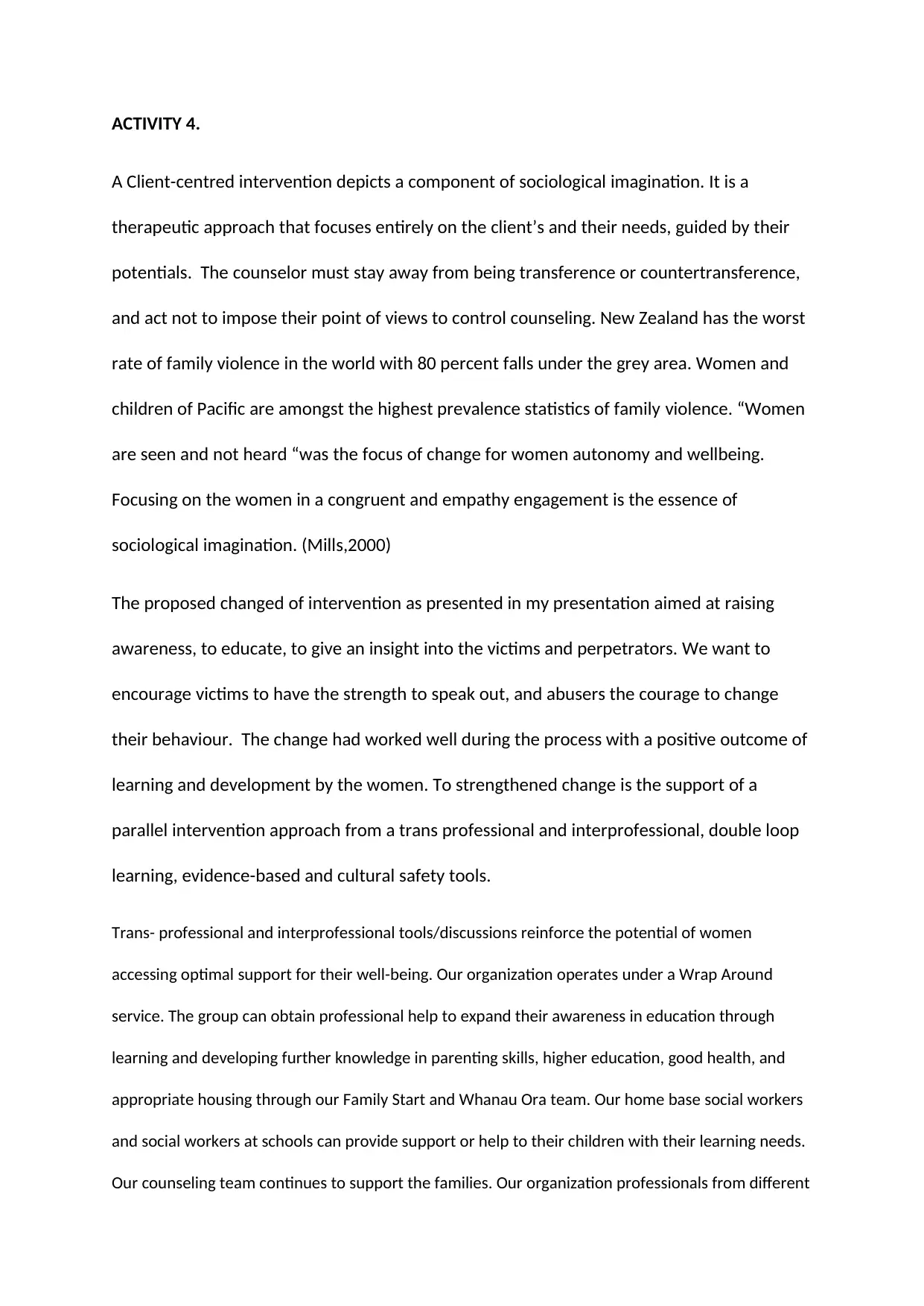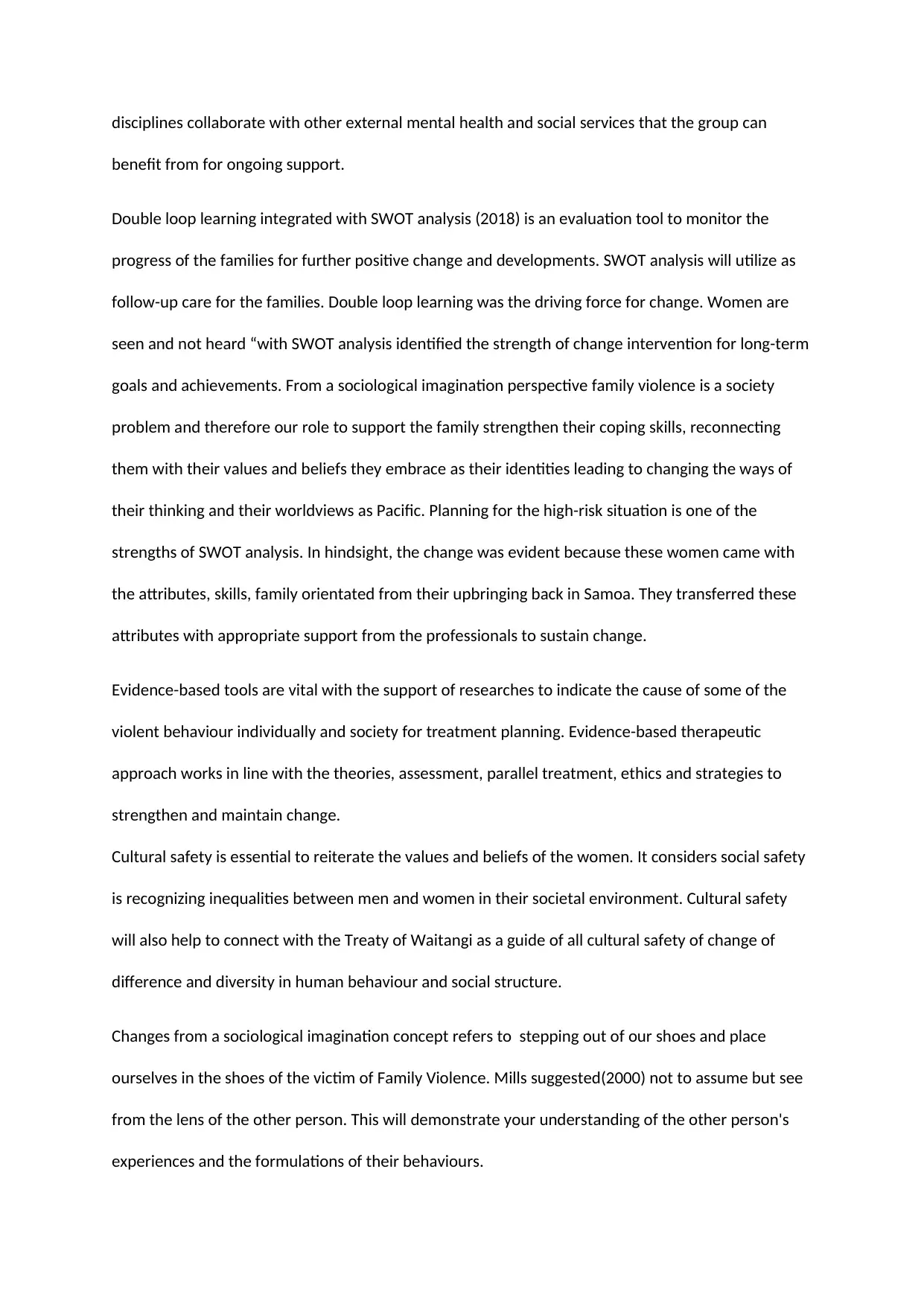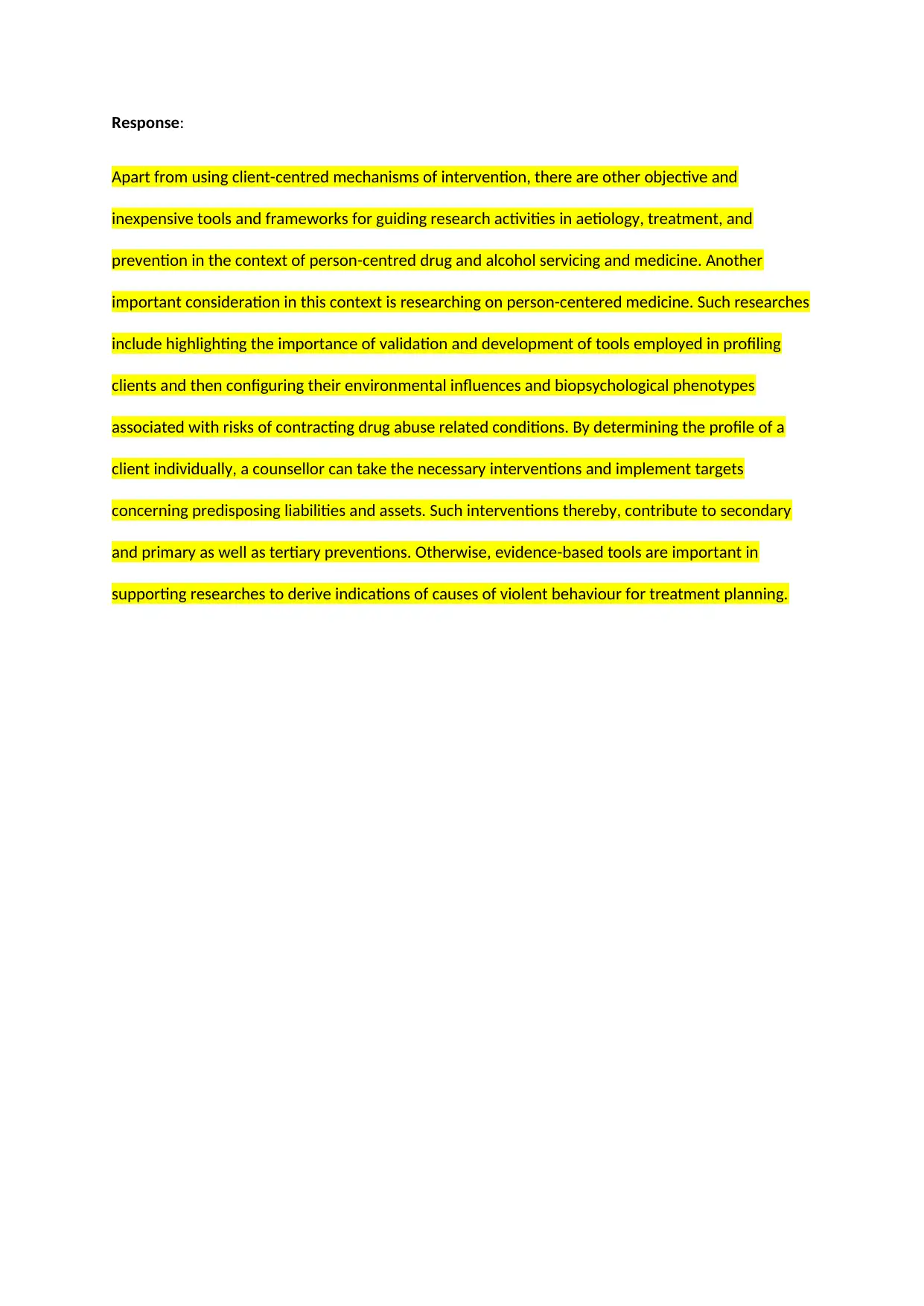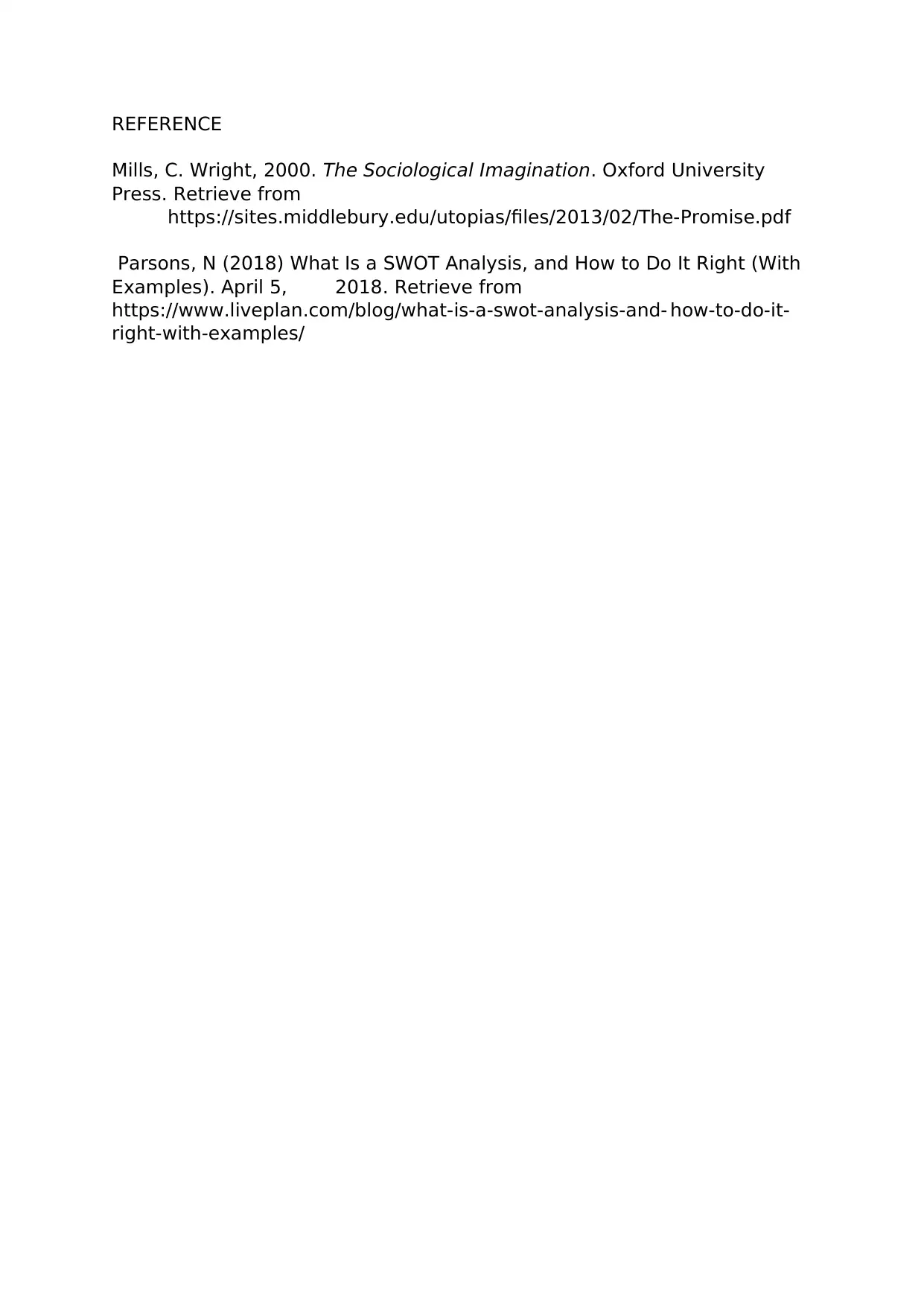Client-Centred Intervention and Sociological Imagination in Addressing Family Violence
VerifiedAdded on 2023/05/29
|4
|908
|388
AI Summary
This article discusses the significance of client-centred intervention and sociological imagination in addressing family violence, particularly in New Zealand where the rate of family violence is high. It presents a proposed change in intervention and the tools used to support families in coping with the issue, including trans-professional and interprofessional tools, double loop learning, evidence-based tools, and cultural safety.
Contribute Materials
Your contribution can guide someone’s learning journey. Share your
documents today.

ACTIVITY 4.
A Client-centred intervention depicts a component of sociological imagination. It is a
therapeutic approach that focuses entirely on the client’s and their needs, guided by their
potentials. The counselor must stay away from being transference or countertransference,
and act not to impose their point of views to control counseling. New Zealand has the worst
rate of family violence in the world with 80 percent falls under the grey area. Women and
children of Pacific are amongst the highest prevalence statistics of family violence. “Women
are seen and not heard “was the focus of change for women autonomy and wellbeing.
Focusing on the women in a congruent and empathy engagement is the essence of
sociological imagination. (Mills,2000)
The proposed changed of intervention as presented in my presentation aimed at raising
awareness, to educate, to give an insight into the victims and perpetrators. We want to
encourage victims to have the strength to speak out, and abusers the courage to change
their behaviour. The change had worked well during the process with a positive outcome of
learning and development by the women. To strengthened change is the support of a
parallel intervention approach from a trans professional and interprofessional, double loop
learning, evidence-based and cultural safety tools.
Trans- professional and interprofessional tools/discussions reinforce the potential of women
accessing optimal support for their well-being. Our organization operates under a Wrap Around
service. The group can obtain professional help to expand their awareness in education through
learning and developing further knowledge in parenting skills, higher education, good health, and
appropriate housing through our Family Start and Whanau Ora team. Our home base social workers
and social workers at schools can provide support or help to their children with their learning needs.
Our counseling team continues to support the families. Our organization professionals from different
A Client-centred intervention depicts a component of sociological imagination. It is a
therapeutic approach that focuses entirely on the client’s and their needs, guided by their
potentials. The counselor must stay away from being transference or countertransference,
and act not to impose their point of views to control counseling. New Zealand has the worst
rate of family violence in the world with 80 percent falls under the grey area. Women and
children of Pacific are amongst the highest prevalence statistics of family violence. “Women
are seen and not heard “was the focus of change for women autonomy and wellbeing.
Focusing on the women in a congruent and empathy engagement is the essence of
sociological imagination. (Mills,2000)
The proposed changed of intervention as presented in my presentation aimed at raising
awareness, to educate, to give an insight into the victims and perpetrators. We want to
encourage victims to have the strength to speak out, and abusers the courage to change
their behaviour. The change had worked well during the process with a positive outcome of
learning and development by the women. To strengthened change is the support of a
parallel intervention approach from a trans professional and interprofessional, double loop
learning, evidence-based and cultural safety tools.
Trans- professional and interprofessional tools/discussions reinforce the potential of women
accessing optimal support for their well-being. Our organization operates under a Wrap Around
service. The group can obtain professional help to expand their awareness in education through
learning and developing further knowledge in parenting skills, higher education, good health, and
appropriate housing through our Family Start and Whanau Ora team. Our home base social workers
and social workers at schools can provide support or help to their children with their learning needs.
Our counseling team continues to support the families. Our organization professionals from different
Secure Best Marks with AI Grader
Need help grading? Try our AI Grader for instant feedback on your assignments.

disciplines collaborate with other external mental health and social services that the group can
benefit from for ongoing support.
Double loop learning integrated with SWOT analysis (2018) is an evaluation tool to monitor the
progress of the families for further positive change and developments. SWOT analysis will utilize as
follow-up care for the families. Double loop learning was the driving force for change. Women are
seen and not heard “with SWOT analysis identified the strength of change intervention for long-term
goals and achievements. From a sociological imagination perspective family violence is a society
problem and therefore our role to support the family strengthen their coping skills, reconnecting
them with their values and beliefs they embrace as their identities leading to changing the ways of
their thinking and their worldviews as Pacific. Planning for the high-risk situation is one of the
strengths of SWOT analysis. In hindsight, the change was evident because these women came with
the attributes, skills, family orientated from their upbringing back in Samoa. They transferred these
attributes with appropriate support from the professionals to sustain change.
Evidence-based tools are vital with the support of researches to indicate the cause of some of the
violent behaviour individually and society for treatment planning. Evidence-based therapeutic
approach works in line with the theories, assessment, parallel treatment, ethics and strategies to
strengthen and maintain change.
Cultural safety is essential to reiterate the values and beliefs of the women. It considers social safety
is recognizing inequalities between men and women in their societal environment. Cultural safety
will also help to connect with the Treaty of Waitangi as a guide of all cultural safety of change of
difference and diversity in human behaviour and social structure.
Changes from a sociological imagination concept refers to stepping out of our shoes and place
ourselves in the shoes of the victim of Family Violence. Mills suggested(2000) not to assume but see
from the lens of the other person. This will demonstrate your understanding of the other person's
experiences and the formulations of their behaviours.
benefit from for ongoing support.
Double loop learning integrated with SWOT analysis (2018) is an evaluation tool to monitor the
progress of the families for further positive change and developments. SWOT analysis will utilize as
follow-up care for the families. Double loop learning was the driving force for change. Women are
seen and not heard “with SWOT analysis identified the strength of change intervention for long-term
goals and achievements. From a sociological imagination perspective family violence is a society
problem and therefore our role to support the family strengthen their coping skills, reconnecting
them with their values and beliefs they embrace as their identities leading to changing the ways of
their thinking and their worldviews as Pacific. Planning for the high-risk situation is one of the
strengths of SWOT analysis. In hindsight, the change was evident because these women came with
the attributes, skills, family orientated from their upbringing back in Samoa. They transferred these
attributes with appropriate support from the professionals to sustain change.
Evidence-based tools are vital with the support of researches to indicate the cause of some of the
violent behaviour individually and society for treatment planning. Evidence-based therapeutic
approach works in line with the theories, assessment, parallel treatment, ethics and strategies to
strengthen and maintain change.
Cultural safety is essential to reiterate the values and beliefs of the women. It considers social safety
is recognizing inequalities between men and women in their societal environment. Cultural safety
will also help to connect with the Treaty of Waitangi as a guide of all cultural safety of change of
difference and diversity in human behaviour and social structure.
Changes from a sociological imagination concept refers to stepping out of our shoes and place
ourselves in the shoes of the victim of Family Violence. Mills suggested(2000) not to assume but see
from the lens of the other person. This will demonstrate your understanding of the other person's
experiences and the formulations of their behaviours.

Response:
Apart from using client-centred mechanisms of intervention, there are other objective and
inexpensive tools and frameworks for guiding research activities in aetiology, treatment, and
prevention in the context of person-centred drug and alcohol servicing and medicine. Another
important consideration in this context is researching on person-centered medicine. Such researches
include highlighting the importance of validation and development of tools employed in profiling
clients and then configuring their environmental influences and biopsychological phenotypes
associated with risks of contracting drug abuse related conditions. By determining the profile of a
client individually, a counsellor can take the necessary interventions and implement targets
concerning predisposing liabilities and assets. Such interventions thereby, contribute to secondary
and primary as well as tertiary preventions. Otherwise, evidence-based tools are important in
supporting researches to derive indications of causes of violent behaviour for treatment planning.
Apart from using client-centred mechanisms of intervention, there are other objective and
inexpensive tools and frameworks for guiding research activities in aetiology, treatment, and
prevention in the context of person-centred drug and alcohol servicing and medicine. Another
important consideration in this context is researching on person-centered medicine. Such researches
include highlighting the importance of validation and development of tools employed in profiling
clients and then configuring their environmental influences and biopsychological phenotypes
associated with risks of contracting drug abuse related conditions. By determining the profile of a
client individually, a counsellor can take the necessary interventions and implement targets
concerning predisposing liabilities and assets. Such interventions thereby, contribute to secondary
and primary as well as tertiary preventions. Otherwise, evidence-based tools are important in
supporting researches to derive indications of causes of violent behaviour for treatment planning.

REFERENCE
Mills, C. Wright, 2000. The Sociological Imagination. Oxford University
Press. Retrieve from
https://sites.middlebury.edu/utopias/files/2013/02/The-Promise.pdf
Parsons, N (2018) What Is a SWOT Analysis, and How to Do It Right (With
Examples). April 5, 2018. Retrieve from
https://www.liveplan.com/blog/what-is-a-swot-analysis-and- how-to-do-it-
right-with-examples/
Mills, C. Wright, 2000. The Sociological Imagination. Oxford University
Press. Retrieve from
https://sites.middlebury.edu/utopias/files/2013/02/The-Promise.pdf
Parsons, N (2018) What Is a SWOT Analysis, and How to Do It Right (With
Examples). April 5, 2018. Retrieve from
https://www.liveplan.com/blog/what-is-a-swot-analysis-and- how-to-do-it-
right-with-examples/
1 out of 4
Your All-in-One AI-Powered Toolkit for Academic Success.
+13062052269
info@desklib.com
Available 24*7 on WhatsApp / Email
![[object Object]](/_next/static/media/star-bottom.7253800d.svg)
Unlock your academic potential
© 2024 | Zucol Services PVT LTD | All rights reserved.
